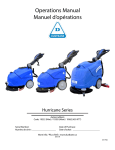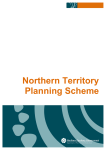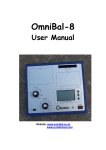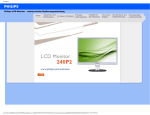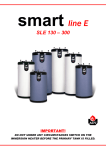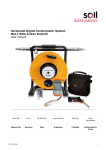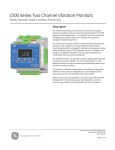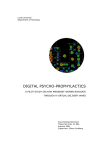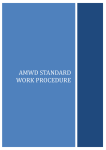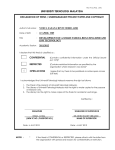Download Water Medication Systems - Northern Territory Government
Transcript
Technote No: 121 October 2006 CATTLE SUPPLEMENTATION Water Medication Systems: Checks for installation and maintenance J. Coventry, Pastoral Production Officer, Alice Springs and K. Hill, former AZRI Station Manager, Alice Springs CONTENTS BACKGROUND 2 COMPONENTS OF A WATER MEDICATION SYSTEM 3 Figure 1. Diagram—system with a NORPRIM® unit 5 Figure 2. Diagram—system with a NUTRIDOSE® unit 5 Figure 3. Photograph—system with a NORPRIM® unit 6 Figure 4. Photograph—system with a NUTRIDOSE® unit 6 TOOLS 7 INSTALLATION OF A WATER MEDICATION SYSTEM 7 Equation 1. Minimum workable volume for a concentrate tank 10 Equation 2. Volume of water in trough 11 Equation 3. Average weight of nutrient consumed per head per day 12 MAINTENANCE OF A WATER MEDICATION SYSTEM 13 REFERENCES 15 SUBJECT INDEX 16 BACKGROUND Nutrient supplementation of cattle has been widely undertaken on native rangeland pastures throughout the Northern Territory to compensate for deficiencies in dietary nitrogen, phosphorus and sulphur. Cattle supplemented with non-protein nitrogen have a higher requirement for supplementation with sulphur, particularly when consuming high levels of browse on arid rangelands. Methods of supplementing cattle have included lick blocks, loose (dry) mixes and water medication. Water medication systems work best where cattle drink exclusively from troughs and have no access to uncontrolled sources of water, e.g. surface water. The proven positive aspects of water medication systems generally outweigh the negative aspects. Positive Aspects of Water Medication Systems Negative Aspects of Water Medication Systems • Cheaper than proprietary lick blocks. • Up-front capital cost to install. • Supply of adequate amounts of appropriate nutrients. • Under-use when surface water is available. • Limited congregation of cattle around watering points—there are no lick blocks or loose mixes to attract cattle. • Knowledge and skill are needed to operate safely. • Reported failures. The reasons for reported failures have included: • Operator error, e.g. failure to set a safe dose rate; modifications that cause failure of the manufacturer’s original system design (1, 2, 3). • Equipment malfunction, e.g. water meter inaccuracy, solenoid valve failure, pump over-delivery. • System failure, e.g. nutrient-line pressure variation, nutrient-line siphoning, urea layering in concentrate tank. • Damage, corrosion and wear on equipment and fittings, e.g. chewing on electrical wires by wildlife or livestock and wear of moving mechanical parts. Technological improvements in the design and safety features of water medication systems have greatly reduced cost and improved safety; however, safe use of water medication still requires regular checking and maintenance of the system. At worst, critical failure of a water medication system can result in urea poisoning and death of cattle. This Technote lists practical points to consider when installing, checking and maintaining a water medication system. The Technote focuses on systems that use electronic water medication units and nutrient dry mixes. Two units that have been used successfully in the Northern Territory are the NORPRIM® unit and the NUTRIDOSE® unit. Extrapolation of listed practical points to other systems and other nutrient supplement ingredients for water medication should be done with care. © Northern Territory Government, 2006 Page 2 of 17 COMPONENTS OF A WATER MEDICATION SYSTEM ESSENTIAL AND OPTIONAL FEATURES (also see Figures 1 and 2) Anti-siphon tube Prevents siphoning of nutrient concentrate where the level of the concentrate tank is above the medicated trough. This is an air vent (e.g. a fitted copper tube or proprietary plastic air breather) that is inserted into the outlet nutrient-line as an optional safety feature. Battery A DC 12-volt battery is used to power the control box, pump and solenoid valve. The required battery size depends upon the number of cattle watering on the medicated trough. For example, a new car battery can be used. An 18 amp-hour battery is sufficient to power a water medication unit for 1,000 head of cattle. Some electronic water medication units are powered by a 240-volt supply with a converter that replaces the battery and regulator (4). Concentrate tank Holds the nutrient concentrate solution during preparation and covered storage. To assist smooth in-flow of fresh nutrient dry mix, a removable lid or a wide access-hole in the roof of the concentrate tank is advised (4). As with the pipe fittings, polythene should be used in preference to metal products. The size of a concentrate tank should be sufficient to hold at least enough nutrient concentrate for supplementation of all the cattle on the medicated trough(s) during the period between refills (see example in Equation 1). Concentration monitor Monitors and regulates concentration of nutrient concentrate in the water-line. This is an optional safety feature that may be operated with a mixing chamber and an alternative fresh water supply. This safety feature may be considered if the risk justifies the cost (e.g. NUTRIDOSE®) (5). Control box An electronic control box monitors and records water-flow, plus controls the injection of nutrient concentrate. Gate valve Prevents the flow of nutrient concentrate through the inlet nutrient-line into the pump, when a malfunction is detected in some electronic water medication units (e.g. NUTRIDOSE®) (6). In-line nutrient filter Removes sediment from the in-line nutrient concentrate. This is inserted into the inlet nutrient-line between the concentrate tank and the pump. In-line nutrient tap Allows the pump function to be checked. The tap is fitted into the outlet nutrientline. If an in-line nutrient tap is not available, then the hose clamp on the outlet nutrient-line will need to be disconnected when conducting checks or measuring the injection of nutrient concentrate. Nutrient concentrate Is the liquid nutrient that is prepared using nutrient dry mix, dissolved in water at a specific concentration (also see Equation 3). Nutrient dry mix Is the customised or proprietary premix—dry nutrient ingredients that are formulated for water medication. © Northern Territory Government, 2006 Page 3 of 17 Nutrient flow meter Monitors and controls the flow of nutrient concentrate that is injected through the outlet nutrient-line, from the end of one pump cycle to the end of the next. This is a safety feature (e.g. NUTRIDOSE®) (5). Nutrient-line Is the set of hose lines which carries nutrient concentrate from the concentrate tank to the pump (inlet), and from the pump (outlet) to the water-line or trough. The hose should be flexible, re-enforced and able to withstand the corrosive nature of the nutrient concentrate (4, 7). One-way valve Stops a backward stream of water from the water-line up into the outlet nutrientline (e.g. during ‘water-hammer’) (2); pressure from the pump ensures that the nutrient concentrate can still be injected into the water-line. Pump Injects nutrient concentrate from the concentrate tank into the water-line or trough. Regulator Prevents over-charging of the battery by the solar panel. Solar panel Charges the battery. The more cattle that water on the medicated trough, the more nutrient concentrate will need to be injected into the trough and the bigger the solar panel will need to be, in order to recharge the battery. Solenoid valve Prevents siphoning of nutrient concentrate from the pump outlet into the waterline. This is a safety feature. Tank-tap Controls the flow of nutrient concentrate out of the concentrate tank into the inlet nutrient-line. The tap is located at the base of the concentrate tank. Water meter Measures water-flow through the water-line to the medicated trough. This has a paddle wheel or turbine sensor that is inserted into the water-line. Water-line Is the water pipe-line carrying drinking water from the stored water supply (e.g. water tank, turkey nest) to the livestock trough via a float valve. Water-line filter Removes algae and sediment from the water-line (8). This is an optional feature that is inserted before the water meter, particularly where the water supply is a turkey nest or open-air tank. A metal mesh (7) or shade-cloth filter on the waterline opening will limit entry of large algal masses. Water-line tap Is an extra tap outlet which may be installed after the water meter to refill the concentrate tank, to activate the water meter during checks on the function of the electronic water medication unit, or to access clean water for rinsing equipment after checks (7). © Northern Territory Government, 2006 Page 4 of 17 outlet nutrient-line with anti-siphon air valve solar panel with electrical wire concentrate tank NORPRIM® stored water supply inlet nutrient -line electronic water medication unit outlet nutrient-line water-line water meter with sensor and electrical wire injection point with one-way valve and in-line nutrient tap water-line tap WATER FLOW Figure 1. Diagram of a system with a NORPRIM® unit This diagram is based on working installations and the literature supplied by the manufacturer (4). solar panel with electrical wire concentrate tank NUTRIDOSE® stored water supply electronic water medication unit inlet nutrient -line outlet nutrient-line water-line injection point with one-way valve and in-line nutrient tap water-line tap water meter with sensor and electrical wire WATER FLOW Figure 2. Diagram of a system with a NUTRIDOSE® unit This diagram is based on working installations and the literature supplied by the manufacturer (2). © Northern Territory Government, 2006 Page 5 of 17 nutrient concentrate tank water supply solar panel tanktap electronic water medication unit inlet nutrientline water-line Figure 3. Photograph of a system with a NORPRIM® unit Source: NORPRIM Pty Ltd. This system demonstrates protection of the electronic water medication unit with a fence and roof. Other features of this system are explained in the literature supplied by the manufacturer (4). concentrate tank solar panel battery electronic water medication unit water-line tap in-line nutrient tap and oneway valve water meter water-line Figure 4. Photograph of a system with a NUTRIDOSE® unit Source: Napperby Station, N.T. This system demonstrates the protection of the electronic water medication unit with an innovative idea—a recycled refrigerator cabinet. Other features of this system are explained in the literature supplied by the manufacturer (2). © Northern Territory Government, 2006 Page 6 of 17 TOOLS ESSENTIALS FOR INSTALLATION AND MAINTENANCE OF A WATER MEDICATION SYSTEM Buckets Electric drill Electrical box Garden hose Hose brackets Hose clamps Measuring cup Pipe fittings Pipe wrenches Plastic quick ties Tool box Used to measure the rate of water-flow from the water-line into the medicated trough (e.g. 20-litre and 10-litre buckets). Used to attach the solar panel and fasten screws on the concentrate tank lid. Contains: electrical joiners , electrical tape, electrical wires, electrical pliers, multimeter, screw drivers. Used to put around electrical leads for protection against chewing by wildlife and livestock. Dripper line may be used as an alternative. Used (with screws) to fasten the nutrient-line to solid surfaces. Used (with screws) to connect the nutrient-line onto pipe fittings. These are preferable to elbow fittings. Used to measure the amount of nutrient concentrate injected in each pump cycle, e.g. a 500mls-volumetric cylinder. Used to connect the nutrient-line or the water meter to other components (concentrate tank, pump, water-line). Used to adjust pipe fittings (i.e. large and small ‘stilsons’). Used to fasten the nutrient-line to pipes. Contains: CRC spray, gaffer tape, hammer, screws, small file, spanners, stanley knife, wire brush. INSTALLATION OF A WATER MEDICATION SYSTEM CRITICAL ITEMS TO CHECK Water supply 1. Check water quality, including ‘total alkalinity’ of the water. ‘Total alkalinity’ describes the buffering capacity of the water (1); it can be found recorded on bore advice sheets. If ‘total alkalinity’ is high, then hydrolysed urea in the nutrient concentrate will evaporate as ammonia gas. If this occurs, the manufacturer of the water medication system will need to be contacted for advice on addition of acid to the water supply or use of an acidic nutrient dry mix in the system. Nutrient concentrate (See Equation 1 to work out the minimum workable volume for a concentrate tank) 2. Check instructions on the bag of the nutrient dry mix. Instructions may be as easy as “One 25 kg-bag to make up 250 litres of nutrient concentrate”. 3. Use the known or calculated volume of the concentrate tank to work out how many bags of nutrient dry mix need to be put into the concentrate tank to make up the required concentration and volume of nutrient concentrate. 4. Turn off the tank-tap before preparing a batch of nutrient concentrate in the concentrate tank. © Northern Territory Government, 2006 Page 7 of 17 5. Mix in the nutrient dry mix until it has dissolved and no sediment remains on the bottom of the concentrate tank. A fire-fighting pump is recommended for thorough mixing (3). 6. Check clarity of the nutrient concentrate. If the nutrient concentrate is cloudy because of undissolved nutrient dry mix, it will need to be better mixed. If the nutrient concentrate is cloudy because of precipitate such as biuret (condensation product of urea), a different nutrient dry mix may be needed. 7. Turn the tank-tap back on and then off to check the in-line nutrient filter for sediment. Solar panel, control box and water meter 8. Mount the solar panel to maximise exposure to sunlight. The optimal position is facing north, tilted horizontally at 5o to 10o more than the latitude of the location. For properties north of the Tropic of Capricorn this would be tilted no more than 32o to the horizontal, reducing to 5o to the horizontal at the equator (pers. comm. BP SOLAR RF Industries, 2005). 9. Protect the control box so that it is not exposed to flooding, rainfall, UV radiation or interference by wildlife and livestock (4). Mounting off the ground with protective roofing and a fenced enclosure may be required (3, 8). 10. Protect exposed electrical leads from being chewed by wildlife and livestock (3). Enclose completely in garden hose. 11. Insert the water meter into a non-turbulent length of water-line that is at least 10 pipe-diameters in length before the water meter and 5 pipe-diameters in length after the water meter (2), plus clear of flooding (8). 12. Check the accuracy of the water meter and control box (3) by comparing the meter reading with outflow from the water-line. Use a bucket of known volume to measure the outflow. If the filling capacity of the medicated trough is known (see Equation 2), the trough can also be used to double-check the outflow. 13. Calibrate the water meter if required. Use control box dials according to the manufacturer’s instructions. Safe dose rate (See manufacturer’s instructions for all control box settings) 14. Adjust the control box settings to set the dose rate of nutrient concentrate. If using a NORPRIM® electronic water medication unit, set the water-flow volume that will activate the pump and set the period of pump activity (4). © Northern Territory Government, 2006 Page 8 of 17 If using a NUTRIDOSE® electronic water medication unit, set the percentage of nutrient concentrate (including variation) that the pump will inject into the set water-flow (10 litres) (6). When starting water medication of a cattle mob, plan to build up the daily dose of nutrient concentrate from half- to full-strength over two weeks (3, 8). 15. Check the function of the pump. Open the in-line nutrient tap at the injection point and then activate a pump cycle so that the solenoid valve opens the pump outlet while the pump injects a volume of nutrient concentrate. A pump cycle is activated, either by pressing the ‘TEST’ / ‘PRIME’ button, or by letting water flow through the water-line and water meter. Water-flow can be initiated by depressing the float valve on the trough or by opening the extra water-line tap after the water meter. Measure the volume (and period) of nutrient concentrate injected by the pump. Re-adjust the control box settings if required and recheck the pump function. 16. Check the function of the solenoid valve. This is a safety feature. If nutrient concentrate flows from the outlet nutrient-line only while the pump is injecting, then this indicates that the solenoid valve is functioning correctly (opening and closing). 17. Check the automatic cut-off function on the pump. This is a safety feature. If using a NORPRIM® electronic water medication unit, press the ‘TEST’ button. If the unit is functioning correctly, the pump will cut out after 10 to 12 seconds. If using a NUTRIDOSE® electronic water medication unit, press the ‘PRIME’ button and the pump will cut out after approximately 15 seconds. 18. Close, clean and copy details when checks are complete. Ensure that the in-line nutrient tap and water-line tap are closed, clean-off spillage of nutrient concentrate from the electronic water medication unit, and copy the date, settings and readings into the records for the installed water medication system. © Northern Territory Government, 2006 Page 9 of 17 EQUATION 1. MINIMUM WORKABLE VOLUME FOR A CONCENTRATE TANK Based on: Critical factors: Number of cattle to supplement (head of adult cattle) Maximum seasonal volume of nutrient concentrate drunk (millilitres per head per day) Period between refills of concentrate tank (days) … number of adult cattle equivalents on the medicated trough(s) … control box settings for nutrient concentrate injection into water-line average volume of water drunk by cattle in summer … … period between bore-run checks Minimum workable volume of concentrate tank = (number of cattle to supplement) X (maximum seasonal volume of nutrient concentrate drunk) X (period between refills of concentrate tank) EXAMPLE: 200 head of breeder cows are supplemented with a maximum of 500 mL of nutrient concentrate per head per day, and the concentrate tank will be re-filled on every third bore-run; if a bore-run occurs every four days, then every third bore run occurs every 12 days. The volume of a concentrate tank needs to be at least …. 200 X 500 X 12 = 1,200,000 mL = 1,200 L © Northern Territory Government, 2006 Page 10 of 17 EQUATION 2. VOLUME OF WATER IN TROUGH Based on: Critical factors: Diameter (or width) of trough Length of trough (0.7854) (diameter of trough) X (length of trough) X 0.7854 ÷ 2 2 = EXAMPLE: The volume of approximately… water held by the trough is (0.4) X 5 X 0.7854 ÷ 2 314.16 L distance from one end of the trough to the other … mathematical term, pi (π) divided by 4 2 π X (diameter of trough ÷ 2) X (length of trough) ÷ 2 The standard calculation of the same example gives the volume of water held by the trough to be approximately… (22 ÷ 7) X (0.4 ÷ 2)2 X 5 ÷ 2 2 = … EXAMPLE: A trough is 0.4 metres wide at the water surface and 5 metres long. 0.31416 m distance across the trough at water level Approximate volume of water in trough (standard calculation) Approximate volume of water in trough (easy calculation) = … (metres) (metres) Easy calculation factor = 1 3 = 0.31428 m = 314.28 L 3 1 This is a useful measurement to help check the water meter; however, it may over-estimate the actual volume of water in the trough if the depth of the water is less than the radius (half the trough width). © Northern Territory Government, 2006 Page 11 of 17 EQUATION 3. AVERAGE WEIGHT OF NUTRIENT CONSUMED PER HEAD PER DAY Critical factors: Based on: Concentration of nutrient concentrate in concentrate tank (grams per millilitre) Volume of nutrient concentrate drunk by cattle (millilitres per head per day) … weight of nutrient dry mix mixed in concentrate tank … volume of new nutrient concentrate prepared in concentrate tank … control box settings for nutrient concentrate injection into water-line … average volume of water drunk by cattle Average weight of nutrient consumed per head per day = (concentration of nutrient concentrate in concentrate tank) X (volume of nutrient concentrate drunk by cattle) EXAMPLE: Five bags of nutrient dry mix, each weighing 25 kg, are mixed in the concentrate tank to make up 1,250 L of nutrient concentrate. From this, cattle receive on average, 500 mL (½ litre) per head of nutrient concentrate per day in the drinking water. The average weight of nutrient consumed per head per day is … (5 X 25) ÷ 1,250 X 0.5 = 0.05 kg = 50 g © Northern Territory Government, 2006 Page 12 of 17 MAINTENANCE OF A WATER MEDICATION SYSTEM CRITICAL ITEMS TO CHECK Overall system 1. Carry out maintenance checks on the water medication system on each bore run. Problems with the electronic water medication unit may need to be referred back to the manufacturer. A telemetry system (6) or concentration monitor (5) may be warranted in certain situations to assist with monitoring and maintenance of safe function. 2. Record date, settings, repairs and readings. Records should be kept on a permanent database (1). 3. Vary the dose rate of nutrient concentrate if required, to suit the seasonal water consumption and nutrient demand. When water consumption at the trough falls (e.g. when cattle stay out on surface waters after rain), consider either using a low dose rate or turning-off the water medication system. 4. Clean out the water medication system before turning it off for a long period. The electronic water medication unit should be flushed and cleaned with fresh water to prevent precipitation of residual nutrient concentrate in the nutrient-line or corrosion of internal parts. Nutrient concentrate remaining in the concentrate tank should be pumped to another tank to use. Water supply and trough 5. Check the level of stored water supply. 6. Check the medicated trough. Clean the trough if required. Algae are associated with increased breakdown of urea. Adjust the float valve if required (2). If the float valve fails to fully close when the trough is full, it may result in an inadequate water-flow for water meter function, plus over-flowing of the trough. Identify and resolve problems related to ammonia odour in the trough-water if required. If the water smells of ammonia, either the water supply has high ‘total alkalinity’, or the concentrate tank is overheating, or the water-line between the nutrient concentrate injection point and the trough is excessively long (1). Solar panel, control box and battery 7. Check that the control box is operational. Check that the wiring is intact (not loose or broken). The battery should be charged, the battery terminals and clamps should be free of corrosion, and the battery water levels should be topped up as required (1). Clean the glass on solar panel to remove dust and bird droppings if required (8). © Northern Territory Government, 2006 Page 13 of 17 Water flow and nutrient concentrate 8. Record the water meter reading. 9. Record the total volume of nutrient concentrate dispensed since the last recording. The volume can be calculated, based on the control box settings and recordings on the water meter; it may also be electronically logged (2). A calibrated (notched) dipstick in the concentrate tank can also give a rough indication of the volume used between recordings. The recorded volume of dispensed nutrient concentrate is used to calculate the average weight of nutrient dry mix consumed in the drinking water per head per day (see Equation 3). 10. Stir the concentrate tank. Long periods of non-use or minimal use may result in layering of the nutrient concentrate. If layering is a major problem, additional management options include a solar stirrer or a differential draw-off device (2). 11. Re-fill the concentrate tank with freshly prepared nutrient concentrate if required. Follow the instructions of the manufacturer and/or installer of the water medication system. A reasonable period between refills is every 10 to 15 days (8) (see ‘Installation of a Water Medication System’). Record the volume of fresh nutrient concentrate prepared, including the weight of nutrient dry mix used. A calibrated dipstick in the concentrate tank can simplify measurement of the remaining and added volume of nutrient concentrate (1). 12. Identify and resolve problems related to ammonia odour in the concentrate tank if required. If the nutrient concentrate smells of ammonia, the water supply may have high ‘total alkalinity’ or the concentrate tank may be overheating. System function 13. Check the function of the pump and water meter. Check that the water meter activates the pump at the set level to correctly inject nutrient concentrate at the set volume (and period). This is most simply done by opening both the in-line nutrient tap at the injection point, plus the extra water-line tap below the water meter. 14. If the measured water-flow is faulty, then check the water-line filter and water meter (paddlewheel/turbine) for function and freedom from mineral or organic matter build up. Clean if required. Where ‘hard’ water causes a precipitate to build-up, the paddlewheel/turbine may need to be cleaned in weak acid every 6 months or even replaced every 12 months (2). 15. If injection of the nutrient concentrate is faulty, then check the pump filter and in-line nutrient filter for sediment. If required, also check the solenoid valve and one-way valve (if present) for function. © Northern Territory Government, 2006 Page 14 of 17 16. Check the automatic cut-off function on the pump. 17. When checks are complete, ensure that the in-line nutrient tap and water-line tap are closed, clean-off spillage of nutrient concentrate on the electronic water medication unit, reset the control box, and update the records. REFERENCES 1. Entwistle, K. and Jephcott, S. (2005). Water medication: A guide for beef producers. Meat and Livestock Australia Limited 2. Wood, T. (2004). PFSA Nutridose Manual: Supplementing livestock with Nutridose: A practical guide to Nutridose solar injectors. Available online: [http://www.nutridose.com.au/Manual.pdf] (Accessed February 2005) 3. Hill, K. (2003). Project: PDS 97/10 Effectiveness of Water Medication to Supplement Breeder Cattle in Spinifex Country, Producer Demonstration Site, Alice Springs District, December 1998 - November 2001. Meat and Livestock Australia, NT Department of Business, Industry and Resource Development (Primary Industries Group): Alice Springs, N.T. 4. NORPRIM (2004). NORPRIM Nutrient Dispensing Systems: Installation and Operation Manual NORPRIM (a division of McEvoy Rural Holdings Pty Ltd): Mitchell, Qld 5. Wood, T. (2005). Nutridose Concentration Monitor: A major breakthrough in water medication. Available online: [http://www.nutridose.com.au/press/Conc%20monitor.htm] (Accessed February 2005) 6. Thomson, F. (rev.) (2003). (Operating Manual / User manual) Nutridose Controller and Monitor, Document Number M0021. Available online: [http://www.nutridose.com.au/MonitorManual.pdf] (Accessed February 2005) 7. Dobson, J. (2005). Water Medication Systems (pers. comm.). Primary Industries, Alice Springs, N.T., (February 2005) 8. Somers, S. (2004). Nutridose Installation Guide: Procedure to setup a water medicator on a turkeys nest or water tank. Compact disc. (Accessed February 2005) © Northern Territory Government, 2006 ISSN 0158-2755 Agdex No. 420/64 Disclaimer: This Technote is based on practical experiences from development, installation and maintenance of water medication systems for cattle supplementation in the Alice Springs District, plus suggestions by a private contractor and advice of major commercial manufacturers. The examples used are intended to emphasise the care required for safe installation and regular maintenance of water medication systems. Up-to-date advice should also be sought from the manufacturers of the equipment and nutrient supplement, experienced technical field personnel and other relevant publications (see References). While all care has been taken to ensure that information contained in this Technote is true and correct at the time of publication, the Northern Territory of Australia gives no warranty or assurance, and makes no representation as to the accuracy of any information or advice contained in this publication, or that it is suitable for your intended use. No serious, business or investment decisions should be made in reliance on this information without obtaining independent/or professional advice in relation to your particular situation. © Northern Territory Government, 2006 Page 15 of 17 SUBJECT INDEX SUBJECT PAGE SUBJECT G A acid 7, 14 garden hose algae 4, 13 gate valve alkalinity 7, 13, 14 H ammonia 7, 13, 14 hose bracket(s) anti-siphon tube 3, 5 automatic cut-off 9, 15 battery regulator bird droppings biuret bore run bucket 3, 4, 6, 13 … see regulator 13 … see precipitate 10, 13 7, 8 C cabinet check(s) concentrate tank concentrate tank-tap concentration monitor control box corrosion 7, 8 3 7 3, 7 I in-line nutrient tap 3, 8, 15 3, 5, 6, 9, 14, 15 L livestock 2, 4, 7, 8 M maintenance measuring cup 2, 7, 13 7 N 6 2, 3, 4, 7, 8, 9, 10, 11, 13, 14, 15 2, 3, 4, 5, 6, 7, 8, 10, 12, 13, 14 … see tank-tap 3, 13 3, 8, 9, 10, 12, 13, 14, 15 2, 4, 13 nutrient concentrate nutrient dry mix nutrient flow meter nutrient pump nutrient-line 5 3, 4, 6, 7, 8, 9, 10, 12, 13, 14, 15 2, 3, 7, 8, 12, 14 4 … see pump 2, 3, 4, 5, 6, 7, 9, 13 O one-way valve 4, 5, 6, 15 P photograph(s) D diagram(s) hose clamp(s) in-line nutrient filter B battery PAGE pipe fitting(s) 6 3, 7 pipe wrench 7 plastic quick tie 7 differential draw-off device 14 dipstick 14 precipitate 8, 14 2, 8, 13 protection 6, 7 dose rate E electric drill 7 electrical box 7 electrical lead 7, 8 fire-fighting pump float valve flooding 2, 3, 4, 7, 8, 9, 13, 14, 15 pump cycle … see pump function pump filter pump function F fence pump 6, 8 15 3, 9, 14, 15 R 8 rain(fall) 8, 13 4, 9, 13 records 9, 13, 15 8 © Northern Territory Government, 2006 refill(s) Page 16 of 17 3, 4, 10, 14 SUBJECT PAGE 3, 6, 8 S safety feature(s) 2, 3, 4, 9 3, 4, 8, 15 siphoning 2, 3, 4 solar panel 4, 5, 6, 7, 8, 13 solar stirrer 14 spillage surface water 2, 3, 4, 9, 15 9, 15 … see uncontrolled water T tank-tap telemetry tool box trough volumetric cylinder water consumption water flow water meter water quality water supply water-line water-line filter water-line tap 4, 6, 7, 8 13 wildlife wire brush 7 2, 3, 4, 7, 8, 9, 10, 11, 13 U uncontrolled water 2, 13 UV radiation 8 urea layering 2, 14 urea poisoning urea breakdown … see measuring cup W sediment solenoid PAGE V R cont’d roof SUBJECT 2 7, 13 © Northern Territory Government, 2006 Page 17 of 17 … see trough 3, 4, 7, 8, 9, 13, 14 2, 4, 5, 6, 7, 8, 9, 11, 13, 14 … see algae, alkalinity, ammonia, precipitate 3, 4, 5, 6, 7, 13, 14 3, 4, 5, 6, 7, 8, 9, 10, 12, 13 4, 14 4, 5, 6, 9, 14, 15 2, 7, 8 7

















